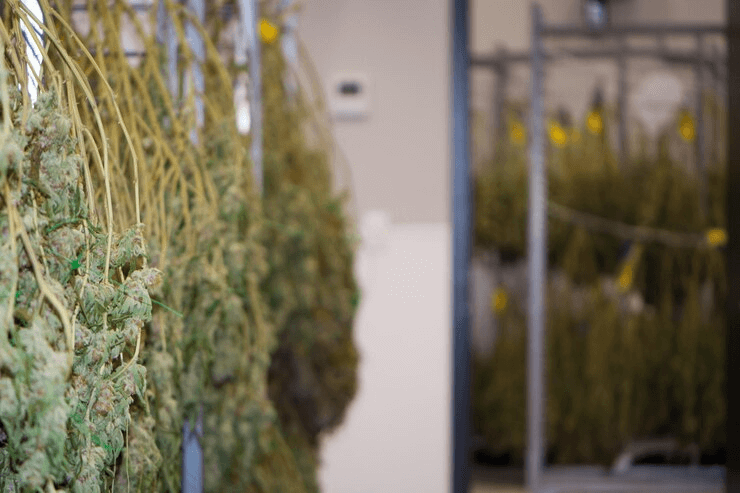Drying weed is one of the most underestimated yet critical stages in cannabis cultivation. It’s the bridge between harvest and consumption, where the true character of the plant begins to emerge. Growers often spend months nurturing their crops—monitoring light cycles, adjusting nutrients, and protecting their plants from pests—only to lose quality in a matter of days because of poor drying practices. What makes drying so important is that it’s not simply about removing water; it’s about preserving the essence of the plant—its aroma, potency, and smoothness.
To understand how to dry weed properly, we have to move beyond technical steps and see the process as a transformation. Cannabis, at harvest, is alive with moisture and enzymes. Within its trichomes lie cannabinoids and terpenes that define its flavor and effect. The drying process, when done correctly, allows those compounds to stabilize, while chlorophyll breaks down and harshness fades. It’s a moment when science meets patience—an act of restraint where the grower must do less rather than more, allowing nature to finish what cultivation began.
The Moment of Harvest: Setting the Stage for Drying
Everything that happens in drying is influenced by what happens at harvest. Timing the harvest correctly sets the tone for the entire post-harvest process. When trichomes shift from clear to milky white with hints of amber, it signals peak maturity. Cutting too early results in less potent buds that dry too quickly; too late, and the plant becomes more resinous and prone to mold.
Once harvested, how the plants are handled immediately impacts drying. Some growers cut the entire plant and hang it upside down, while others prefer to remove branches individually. The choice depends on drying space, strain structure, and personal preference, but the goal remains the same: to slow the drying rate enough to allow the plant’s internal chemistry to settle naturally.
Rough handling during harvest can crush trichomes and expose plant tissue, accelerating moisture loss unevenly. A careful harvest—where branches are trimmed gently and handled by the stem—helps preserve the delicate oils that define the final product’s aroma.
When the plants are brought into the drying room, they’re no longer growing organisms but still living systems. Enzymatic activity continues for a short period, breaking down sugars and chlorophyll. If drying begins too fast, these processes halt abruptly, leading to harsh-tasting smoke. If it’s too slow, mold may develop. Thus, the harvest moment marks the beginning of a balancing act between moisture, airflow, and time.
Understanding the Science of Moisture and Airflow
Drying weed is, at its core, about controlling how water leaves the plant. Freshly harvested cannabis contains around 70–80% water by weight. The goal is to reduce that to about 10–15%, where buds are firm but not brittle. But not all water inside the plant behaves the same way. Surface moisture—the kind that clings to leaves and outer cells—evaporates quickly. Internal moisture, locked deep within the flower, moves outward more slowly. If the outer layers dry too fast, they form a barrier that traps moisture inside. This phenomenon, known as “case hardening,” is one of the most common mistakes new growers make.
Proper airflow prevents this problem. The drying room must allow for gentle, consistent air movement—not direct wind that desiccates, but a subtle current that carries moisture away from the buds’ surface. Ideally, the air should be replaced gradually, maintaining equilibrium rather than forcing evaporation.
Humidity plays an equally vital role. When relative humidity (RH) stays around 55–60%, the drying process slows to the right pace, usually over 7 to 14 days. If humidity drops below 45%, the process accelerates dangerously; above 65%, mold risk spikes. Many professional growers use dehumidifiers and hygrometers to maintain control, but even small-scale cultivators can achieve consistency with basic monitoring tools and patience.
Temperature complements humidity. Around 60–68°F (15–20°C) is the sweet spot. Higher temperatures may seem to speed up drying, but they also degrade terpenes—volatile aromatic compounds that define flavor and strain identity. A bud dried too hot may retain potency but lose its soul.
Choosing a Drying Method
Drying weed can be done in several ways, but the principles remain constant. Some growers hang entire plants upside down in dark, ventilated rooms. Others trim the buds first and place them on drying racks. Each approach shapes the end product differently.
Hanging the whole plant slows down the drying process because the remaining leaves act as natural moisture regulators. The larger structure retains humidity within the plant mass, allowing even moisture migration from the core to the surface. This method often results in smoother, more aromatic weed. However, it requires space and consistent airflow around each plant, which can be challenging for large harvests.
Drying on racks, by contrast, offers efficiency. Trimmed buds are spread across mesh or metal shelves, allowing air to circulate around them. The process moves faster, and it’s easier to control humidity within confined spaces. The trade-off is that it requires greater vigilance; uneven airflow or unclean surfaces can cause localized mold growth.
In commercial facilities, a hybrid approach is common: branches are hung for several days until moisture content drops to a safe threshold, then transferred to racks for final drying. The goal, always, is balance—enough time for chemical stabilization, without inviting microbial danger.
The Role of Darkness
Light is the silent destroyer of potency. Once harvested, cannabinoids like THC begin to degrade when exposed to light, particularly ultraviolet rays. Terpenes, too, are volatile and sensitive. For this reason, weed should always be dried in darkness. Even small light leaks can accelerate oxidation, fading the buds’ color and altering their aroma.
In nature, cannabis flowers mature under the sun, but once cut, that same light becomes an enemy. A well-designed drying space mimics the calm of a shaded forest floor—cool, dark, and slightly humid. Some growers even paint their drying rooms in matte dark colors to minimize reflection, ensuring that no stray light interferes with the slow transformation taking place.
Patience: The Art of Slow Drying
Perhaps the most difficult aspect of drying weed is restraint. Every grower feels the urge to speed things up—to check the buds, to open the door for extra airflow, to raise the temperature just a little. But cannabis rewards patience. The best weed is always the slowest dried.
During the first few days, the outer surface feels tacky and fragrant. This is when moisture migration is most active. The temptation to accelerate drying can be strong, especially when buds feel “almost done.” But true drying is internal. Beneath the sticky exterior, moisture still moves slowly from the core outward. If the process stops prematurely, that trapped humidity can cause uneven curing later.
Around days seven to ten, depending on density and environmental conditions, buds begin to feel dry to the touch. The smaller stems may snap cleanly rather than bend. The aroma shifts—from the fresh “green” scent of chlorophyll to the deep, rich fragrance of terpenes emerging. This is the sign of a well-paced drying process.
Speed, in drying, always comes at the cost of quality. A rapid dry may produce smokable buds, but they’ll lack smoothness. Harshness, throat irritation, and diminished aroma are the telltale marks of impatience. True craft cannabis retains its soft moisture balance and natural scent, achieved only through time.
The Chemistry of Transformation
Behind the sensory changes of drying lies a fascinating chemistry. As moisture leaves the plant, enzymes continue to break down chlorophyll—the pigment responsible for the bright green color and grassy flavor of fresh cannabis. When this process occurs slowly, chlorophyll decomposes into smaller, less bitter molecules, resulting in smoother smoke.
At the same time, starches and sugars within the plant convert into simpler compounds. If these remain intact, they combust harshly and leave a chemical aftertaste. Controlled drying ensures that enzymes have enough time to metabolize them naturally.
Terpenes, meanwhile, become more pronounced. Some evaporate during drying, but the remaining ones concentrate as water content decreases. This concentration refines the strain’s aroma profile. When done right, drying doesn’t just preserve terpenes—it enhances their complexity, revealing subtle notes that were muted in fresh flowers.
Thus, drying weed is not merely a physical process; it’s biochemical maturation. The plant transitions from a living organism to a finished product, and every environmental factor—the air, the darkness, the temperature—plays a role in shaping that evolution.
Avoiding the Common Pitfalls
Many new growers underestimate the fragility of drying weed. They think once the buds are cut, the hard part is over. But post-harvest mishandling can ruin even the best-grown plants. The most common mistake is drying too fast. High temperatures, strong fans, or low humidity strip moisture rapidly, causing buds to shrink unnaturally and lose aroma.
Another common error is insufficient airflow. Stagnant air creates uneven drying conditions, where some buds remain moist while others overdry. This unevenness encourages mold growth—an invisible enemy that can destroy an entire batch.
Touching the buds too often is another risk. Each time you handle them, you knock off trichomes, reducing potency. Handling should be minimal, ideally by the stems or using gloves.
Lastly, cleanliness cannot be overlooked. The drying space should be as sterile as a kitchen, free of dust and organic residue. Mold spores are everywhere, and even a small contamination can spread quickly in humid environments. A clean, well-ventilated space is the invisible insurance policy of every successful drying operation.
Signs That Drying Is Complete
How do you know when weed is perfectly dried? The signs are subtle but distinct. The outer texture should feel crisp but not brittle. When a small stem is bent, it should snap rather than fold. Buds should still retain a little springiness when squeezed, indicating residual moisture that will support curing.
The aroma is another clue. Fully dried weed no longer smells grassy; it has a deep, earthy, or fruity fragrance characteristic of its strain. The shift in scent marks the end of chlorophyll degradation and the stabilization of terpenes.
Visual cues help, too. Buds appear slightly shrunken, with visible trichomes glistening like frost. The color deepens from vibrant green to muted olive tones, sometimes with hints of purple or orange depending on genetics.
At this stage, the weed is ready for curing—a separate process that further enhances smoothness and flavor. But drying remains the foundation upon which curing depends. If drying is done poorly, no amount of curing can repair the damage.
The Relationship Between Drying and Curing
Though often discussed separately, drying and curing are two stages of the same continuum. Drying stabilizes the plant’s internal chemistry; curing refines it. Once buds reach the right moisture balance, they are placed in sealed containers—often glass jars—to allow slow gas exchange. Inside, residual moisture equalizes, and the flavors deepen.
If buds enter curing jars too wet, mold forms. If they’re too dry, curing has little effect. This is why drying must be precise—it sets the conditions for everything that follows. Properly dried cannabis should hover around 10–12% moisture, enough to remain pliable but not damp.
During curing, chemical processes that began in drying continue: chlorophyll further breaks down, and terpene profiles mature. The smoother, richer smoke associated with premium cannabis begins here, but it depends entirely on a disciplined drying phase.
Commercial vs. Home Drying
While the principles are universal, scale changes the execution. Commercial growers use specialized drying rooms equipped with dehumidifiers, air filters, and environmental sensors. The airflow is calculated to move evenly across all racks, preventing microclimates that might foster mold. Some facilities even employ automated systems that adjust humidity and temperature hourly.
Home growers, by contrast, rely on creativity and attention. A spare room, tent, or closet can become an effective drying space if properly managed. Darkness, moderate airflow, and a consistent environment matter more than expensive equipment.
What unites both scales is awareness. Drying demands observation—feeling the texture, smelling the aroma, and noting the slow evolution of the buds. It’s a process of intimacy between grower and plant, where the senses guide decisions more than any device.
The Emotional Side of Drying Weed
To the uninitiated, drying may seem mechanical, but to those who cultivate cannabis seriously, it’s an emotional process. After months of tending, trimming, and nurturing, the drying room feels like a sanctuary—a place of transition. Each hanging plant tells a story: the struggles of the grow cycle, the weather, the care given.
There’s a quiet satisfaction in watching the green vibrancy soften into earthy tones, in smelling the shift from raw vegetation to the unmistakable fragrance of cured cannabis. Growers often speak of a kind of reverence during this time. It’s not just about producing a product; it’s about completing a cycle.
This reverence translates into discipline. Those who love their craft respect the slow rhythm of drying, knowing that rushing the process betrays the months of work behind it. The patience it demands becomes a meditation of sorts—a reminder that quality cannot be hurried.
The Future of Weed Drying
As cannabis cultivation becomes more sophisticated, drying technology evolves. Modern facilities now use climate-controlled drying tunnels, low-temperature dehydration systems, and automated monitoring. Some employ sensors that analyze moisture content in real-time, ensuring uniformity across batches.
Yet even as technology advances, the fundamental principles remain ancient: darkness, air, and time. Machines may perfect consistency, but they cannot replace the intuition of a grower who knows when a bud is “just right.” The best systems blend automation with artistry, respecting the organic nature of cannabis while using science to enhance control.
There’s also a growing awareness of sustainability. Traditional drying rooms consume significant energy for humidity and temperature control. New designs focus on energy-efficient dehumidifiers and solar-assisted airflow systems, reducing environmental impact without compromising quality.
In the end, the future of drying lies not in speed but precision. As consumers demand cleaner, more flavorful cannabis, drying will continue to define the difference between average and exceptional.
Conclusion: Drying as the Soul of Quality
So, how do you dry weed? Technically, you hang it in a dark, cool, ventilated space and wait until it feels ready. But truly drying weed—the kind that delivers aroma, flavor, and smoothness—requires more than following steps. It requires understanding.
Drying is where cultivation becomes craftsmanship. It’s the final conversation between grower and plant, where moisture, air, and time decide the outcome. Done right, it transforms cannabis from a harvest into an experience. Done wrong, it turns months of work into mediocrity.
To dry weed properly is to respect its nature: to let it breathe, to let it change, and to allow time to complete the alchemy. In the stillness of the drying room, surrounded by the scent of transformation, the patient grower learns the oldest truth in cultivation—that good things cannot be rushed.



